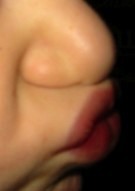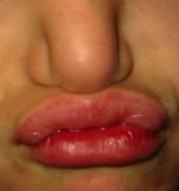Speculative Grammarian is proud to present yet another
installment in the Linguistic Anthropologic Monograph Endowment’s of the World Series.
Hunting the Elusive Labio-Nasal
An Anthropological Linguistic
Study of the Beeg Haan Krrz0
of the World, Vol. 57
Introduction
The now well-known clicks found in certain African languages must have come as quite a shock to the first European linguists who heard them Many of the sounds were familiar, of course, but the idea that they could be a component of language had to have been hard to believe. Even now the languages of Africa have secrets to share—note the recent addition of “right hook v” to the IPA as the symbol for the “labiodental flap” found in numerous African languages.
Perhaps jaded by too many inscrutable sounds in our undergrad phonetics classes, we have collectively found that the labiodental flap, in which the lower lip is smacked against the back of the upper teeth, fails to properly shock. By rights it should be terribly shocking—a new and surprising kind of articulation. It seems uncomfortable, difficult, even unlanguage-like. It should be the subject of passionate debate and thoughtful arguments and -arguments, not the hum-drum subject of dry and dusty meetings of International Phonetic Association and Unicode Consortium committees.
Dismayed by the lack of proper awe that language should inspire in its closest friends—linguists!—I set out to find something shocking, hard to believe, secret, inscrutable, new, surprising, uncomfortable, difficult, and even unlanguage-like. We have all heard the of the impossible articulation from the north—our field’s equivalent of an urban myth. We have all thought it merely an old professor’s tale, told to keep undergrads from asking too many questions, or wandering around the phonetics lab late at night. But I believe all myths have some small kernel of truth to them—so I set out to hunt down the elusive northern labio-nasal articulation.
In the wilds of northernmost I found phonetic riches beyond compare a small, isolated, and little known tribe
—the Beeg Haan Krrz. Beeg Haan Krrzian would be a language isolate—as is the famously infamous Basque—if not for the closely related but much less exciting dialect spoken by their cousins a bit farther south, the Litol Hong Gersh. The of these two languages is nothing special (nonetheless see my forthcoming publication in Psammeticus Press’s Patchwork Series), but Beeg Haan Krrzian phonetics offers something that puts the African labiodental flap to shame.
Linguistic Background
The Beeg Haan Krrz have developed an unusual, probably unique, place of articulation: labio-nasal. Plosives, trills, and fricatives can all be heard coming from between lips and nose of speakers of Beeg Haan Krrz.
| |
 
Labio-nasal articulation in action
|
|
The origin of this shocking
form of articulation (illustrated at right) is not entirely clear—rather, it is entirely unclear. Most speakers claim something along the lines of, “It has always been that way in our language.” However this seems unlikely—especially given the unusual of Beeg Haan Krrzian.
One of the most interesting facts the language is that, unlike sounds of any other language, not just anyone can pronounce these labio-nasal sounds. This kind of “fact” is bandied by poor students of both languages and linguistics as an excuse for their failure to properly pronounce the trilled r’s of Spanish, or the pharyngeal sounds of Arabic. Yet no single normal person is ever born and raised in Mexico or Egypt and unable to acquire these sounds.
While there are no defective native speakers of Beeg Haan Krrzian, it is clear that there could be. Unlike trilling r’s or fricating pharyngeals, the basic articulatory move of the labio-nasal is quite clear (because it is physically external), and also quite impossible for me. While my failure to get down the timing and subtle positioning of the labio-nasal fricative would surprise no one, in fact I can’t even get my upper lip anywhere close enough to my nose to form the labio-nasal stop. It is embarrassing, but linguistically important
In any event, the origin of this difficult articulation is entirely mysterious. Theories range from visual onomatopoeian mimicking of the facial expressions of a sneezing cat (though there are no cats within 1,000 miles) to what I have labeled “cold” theories: keeping the mouth closed conserves heat, expelling warm air onto the lips keeps them from getting chapped, etc. None of the theories are convincing, and the truth will likely never be known
Linguistic Data
Despite the -like quality of “right hook v” and the media blitz surrounding its official coronation into the IPA, I have decided not to introduce any additional symbols to represent these sounds at this time. [A fact for which the SpecGram Typography Team is indeed grateful.—Eds.] Instead, I have decided to simply combine simple symbols in a mnemonic way, tying /m/ (a labial nasal) with superscripted symbols giving the correct voicing and manner of articulation.
Some sample data, in the form of a well-loved Beeg Haan Krrzian tongue-/proverb, is provided below:
|
| ![[tie bar]](tiebar.gif) |
| ![[tie bar]](tiebar.gif) |
| ![[tie bar]](tiebar.gif) |
| ![[tie bar]](tiebar.gif) |
| (1) |
am |
mb |
.uu |
la.tte |
suu.per |
trra.a |
mp |
ba |
mB |
oo |
zel |
trri |
u |
mΦ |
ant |
|
|
lazy.sg |
easy.pl |
seal.pl |
bear.sg |
pres.habit. |
3rd.pl.subj. |
sg.obj. |
be.caught |
|
The easy seals are gotten by the lazy bear. |
Linguistic Analysis
There really isn’t much worth at this stage. This report is merely a preliminary announcement of the unusual articulatory facts of the language. A fuller account will be given in my forthcoming publication in Psammeticus Press’s Patchwork Series.
Tentative Conclusions
More research is necessary to unravel the intricacies of this system.
Said research will require more and abundant funding
References:
Searsplainpockets, Claude. Forthcoming. Arctic Schnozzian Languages: A Straightforward Analysis of Beeg Haan Krrzian and Litol Hong Gersh (with special phonetic appendix of actual interest). Psammeticus Press Patchwork Series.
Notes:
![]() and
and
![]() , and the syllable
, and the syllable
![]() .
.